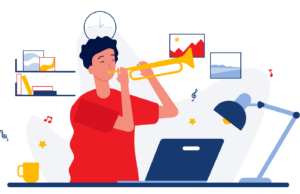Short Direct Answer: Arts are crucial especially during these unusual times. There are plenty of options like Zoom, Facetime, Skype, and a cool new program called Smart Music that make music still possible to teach.
More Information
Students across the country have packed their books away. Today, the virtual classroom remains one of the only ways that teachers can conduct their lessons. This includes the entire spectrum of studies such as History, English, Math; the Arts: music, drama, and the arts.
During the challenging corona age, there are educators and parents questioning the need for arts in our schools, especially when kids can’t even be there. However, we know that there are affordable options.
Online tools such as Zoom, Facetime, Skype and others, have made it possible for teachers to continue teaching and students to continue learning.
As to whether the Arts and music are still relevant when kids can’t be at school will largely depend on the effectiveness of tools like Zoom and Smart Music and if resources can be used by music teachers easily and effectively.

A Music Teachers Perspective: The Arts are more relevant now than ever, even if it’s online.
How do you teach Music Online?
If you are looking for ideas on how to set up your virtual music classroom, why not seek inspiration from teachers that have lots experience teaching music online?
Michele from the Musical Rose, has years of experience teaching online. She also has plenty of resources designed especially for music teachers new to the virtual classroom.
One of the things that people always ask her is, “How do you create Eric Whitacre’s virtual choirs?”. Michele admits that making the exact replica takes tons of expertise and expensive equipment that the majority of music teachers don’t have. However, where there’s a will, there’s a way.It’s not the same quality, but it works. Here’s a link to Michele’s training:
Tips for an online music ensemble performance:
Michele uses a combination of Zoom and Smart Music (these tools will be evaluated later for their effectiveness)
What is Zoom? Zoom is a piece of software commonly used for meetings and conferences. Zoom’s free package admits 100 attendees at a time for 40 minutes only.
What is Smart Music? Smart Music is an online practice tool designed for instrumentalists and vocalists.
Ideas for an online music ensemble performance (some of these instructions are more specific to Smart Music):
-
- Find out which students have access to a laptop, computer, and the internet:You can do this by sending a survey which will give you a clearer idea which students have the internet and which students have laptops or computers. Note: students with a phone can still dial into Zoom.
- Create a set of easy to follow written instructions or provide instructions by a screen cast: Note you may be tech wiz, but don’t assume everyone will be.
- Give students full warm ups before they dive into music practice: . Make sure you send your students warm up videos before they launch into practice. They could be videos of you conducting while giving verbal directions as you would do in the classroom. This will help students who struggle with motivation.
- Don’t overwhelm students with too much: The best advice is to assign small precise sections for students to practice. It can be overwhelming for them if you give them entire pieces of music to practice at once.
- Listen to your ensemble: The recommendation is to record a full assemble of your band every two weeks. You can combine individual musical parts by using Smart Music.
Important advice to teachers: When you set assignments you want to set the “Allow Metronome” feature on Smart Music to exactly the same tempo for all your students.
Before the student submits their work: make sure they hit save to download their file on Smart Music. Add their last name and their part (for example clarinet) to their file. Then upload their part on a Google Drive folder.
Quick Tip: using Garageband, Audacity, or another composing program, you can combine all your individual student’s performances, and send your students the composition discussing where improvements can be made.

What are the best options for teaching and learning Music online?
Skype or Facetime?
Some of the most common tools for virtual teaching are Facetime, Skye and Zoom. They aren’t the only ones, but are probably the most widely used by teachers. Onlinemusicteacher.com, Simon Powis says that Skype and Facetime are most suitable for giving individual lessons. Both of them offer different advantages.
Skype enables you to send text messages and files during lessons. So sharing music scores on Pdfs, and links are easy to do. However, Facetime is often more stable and it has better sound quality than Skype does.
Rating for Skype: Skype offers the option of texting and sharing files during a lesson, but is less stable.
Rating for Facetime: Facetime is more stable and has better sound quality, but doesn’t have the features that skype and Zoom has.
Zoom’s Features for Music Teachers everywhere
- Share Screens: Allows the teacher and their student(s) to share the same PDF music score. You can always use Preview on the Mac (if you have one) to annotate and highlight sections of the score. Bear in mind, you may need to zoom in on a specific section of the scores. (Most people have small screens and it can be difficult to see particular sections of a musical score)
- More than one student in a “room”: multiple students can share the same room. They can dial in from separate locations which makes things safer.
Quick Tip: you may need to ask students to play one at a time. It can be difficult to hear a group playing from separate locations because of sound interference. As the host of the meeting you can mute anybody anytime you like.
- Record your lesson: It’s straightforward to record your lesson. When Zoom is recording you’ll see a small red dot that appears on the feed. You can pause the recording at any time and later send the file to your students’ email.
- Turn on Original Sound: rather than the software attempting to track who is speaking, it transmits a raw audio feed of the microphone. This option helps avoid poor sound quality up to a point. The problem is that this feature requires a lot of buffering and puts you slightly out of sync with your student creating an echo. The way round this is to use headphones.
Rating: good amount of options, but not ideal for bands rehearsing together.
Smart Music Features:
Unlike other tools, smart music is designed for instrumentalists and vocalists. The benefits for students is that they can get instant feedback on their performance in terms of their rhythm and pitch while practicing at home. Smart music is the ideal tool for bands. Students can record their parts separately.
Teachers collect all the parts and combine them and send them back to students. This enables students to understand their part in a band and how they sound with accompaniment. They can also work with teachers to analyze their performance and make improvements. Smart music also allows students to submit and receive classwork to do at home.
Teachers can share students’ progress with their parents by downloading records of the students playing and send it via email to parents during the year.
For Teachers, They Can:
- devise and send separate assignments to the same student that they can do at home.
- Create portfolios of all their students’ work while keeping track of their achievements and student progress.
- Track students’ grades and collect students’ audio recordings.
- Parents can check their child’s grades online.
Here’s more on Smart Music’s features.
Rating: A great all round tool for students and especially for teachers and parents. Our pick for enabling students to get feedback from teachers, parents to keep on their children’s progress, and helps teachers to design different assignments and track students’ achievements.
Other Collaborative Platforms for Student Projects
These platforms or apps enable students to collaborate on projects together. They are great for school bands, or any sort of music group like a string quartet. Before students work together, it is best to set ground rules first.
The most important being that there needs to be discussion before making any changes. As a musician, I know how much it hurts when nobody asks me to make changes to a band practice session.
Soundtrap: A web based DAW (digital audio workstation used for recording, editing, and creating audio files). This tool enables both synchronous (individual recordings and asynchronous (recordings happening at different times). Soundtrap offers both text and video chat. It’s one drawback is that “the synchronization is not immediate as you have to manually sync changes by clicking a button when you or your collaborator(s) update the music”.
Rating: great fun for students, but difficult to manage and coordinate for music teachers especially if they aren’t technically minded.
Now the “Elephant in the Room” – Sound Quality
One of the biggest challenges music teachers face is the sound quality, and there are few platforms that are designed for instrumentals. Poor sound quality means it is difficult for teachers to pick up tone and the dynamics when listening to a student’s rendition of a piece of music.
One solution is asking the student to record a video of their playing on their phone before the lesson. Then to upload their video on YouTube as an unlisted video (not private and send a link to the teacher. Phones produce much better quality than any video call.
Another facet that affects sound quality is internet connection. Both students and their teacher need good internet speeds. Microphones also help, but not as much.
What We Think: The arts are more relevant than ever today, especially with technology like Zoom, FaceTime and Skype that create a new lease of life for the online classroom. Our pick is Smart Music which allows teachers to design different assignments, lessons, and keep track of students grades and provide parents with progress reports.


